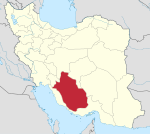Lar, Iran
Lar
لار | |
|---|---|
city | |
| Country | |
| Province | Fars |
| County | Larestan |
| Bakhsh | Central |
| Population (2006) | |
| • Total | 51,961 |
| Time zone | UTC+3:30 (IRST) |
| • Summer (DST) | UTC+4:30 (IRDT) |
Lar (Persian: لار, also Romanized as Lār; also known as Larestan)[1] is a city in and the capital of Larestan County, Fars Province, Iran. At the 2006 census, its population was 51,961, in 12,891 families.[2]
People
The people of Lar are Shia and Sunni. (There used to exist an important Jewish community there. In fact Lar was an important center of Hebraic learning. Most of the Jews immigrated to Shiraz in the 19th century. Some to Israel.Their family name is Larry/Lari).
History
The city was originally called "Lad" after the person who had first established the city. "Lad" is the name of one of Shahnameh's famous heroes. Around 16th and 17th centuries, Lar was considered to be a major stop along the road to the Persian Gulf.
Language
The outstanding specification of Larestan county, and its center Lar is the people's dialect. The vocabulary of the Lari (also referred to as Achomi or Ajami) dialect holds many words in common with Persian, however the syntax is considerably different from current the Persian language. Some believe that the Lari dialect is in fact derived from an older dialect that survived through the impact of Arabic on old Persian language.[citation needed]
Larestani is derived from the medieval Iranian language Pahlavi, the language of the [Parthians], which is also mother to [Modern Persian] and all other existing dialects included in the southwest branch of the Iranian language group.
The name Pahlavi was applied to a number of different dialects spoken in a rather vast area from Ctesiphon in modern-day Iraq to the southern coast of the Persian Gulf. The area corresponds to the greater Pars province. Please see more information about Pahlavi by searching the following phrase: [ The term 'Pahlavi,' in its widest extent, is applied to all the varying forms of the medieval Persian language, from the time when the grammatical inflexions of ancient Persian were dropped, till the period when the modern alphabet was invented, and the language became corrupted into modern Persian by the adoption of numerous Arabic words and phrases.]
Larestani has kept lots of words from Pahlavi and grammatical peculiarities that distinguish it from her sister [Modern Persian]. There is considerably less [Arabic] influence in the diction of Lari than there is in Modern Persian, suggesting that Lari descends from a purer Iranian tongue. Arabic words have mostly been imported indirectly by the influence of Modern Persian.
Some grammatical properties of Lari are also found in other Iranian language such as [Luri] and also in more distanced related languages, such as [Gilaki] and [Kurdish], both of which are included in the northwest branch of Iranian Languages.
Another important feature of Larestani is that it has kept stronger ties to its grandmother old Persian compared to ties between old and modern Persian. That is perhaps due to the fact that being a local language there is less need to be dynamic, less need for development and less need for interaction towards other local languages. Larestani is an oral language and it has no much literature. Written and official language has always been modern Persian.
Civilization
Lar city is divided into two areas: new-city (called Shahre-jadid) and old-city (called Shahre-ghadim). New-city, which was constructed after the historical earthquake of 1960, now accommodates the main population and is considered to be modern in terms of civil and transport engineering (e.g. dead-ends are very rare). The Old city contains the Bazaar of Qaisariye, a pre-Safavid dynasty creation, that was proposed as a UNESCO World Heritage Site on August 9, 2007[3].
Transport
An interesting aspect of Lar city is the construction of an ultra-modern expressway between the city of Lar and a police station 10 km from the city. The 6-lane expressway has been fully upgraded with high luminous lighting and high quality pavement to facilitate the transportation needs of people of Lar in accessing the police station.[4]
References
- ^ Lar, Iran can be found at GEOnet Names Server, at this link, by opening the Advanced Search box, entering "-3072906" in the "Unique Feature Id" form, and clicking on "Search Database".
- ^ "Census of the Islamic Republic of Iran, 1385 (2006)" (Excel). Statistical Center of Iran. Archived from the original on 2011-09-20.
- ^ Bazaar of Qaisariye in Laar - UNESCO World Heritage Centre
- ^ راهها [dead link]
External links
- Gerash - Information on history, demographics and photos of this region
- Khodmooni Forum Connecting Khodmoonis All Over the World
- Emaddeh information Up to date information about Emaddeh & Other Achmoi areas, news, photos, and etc

